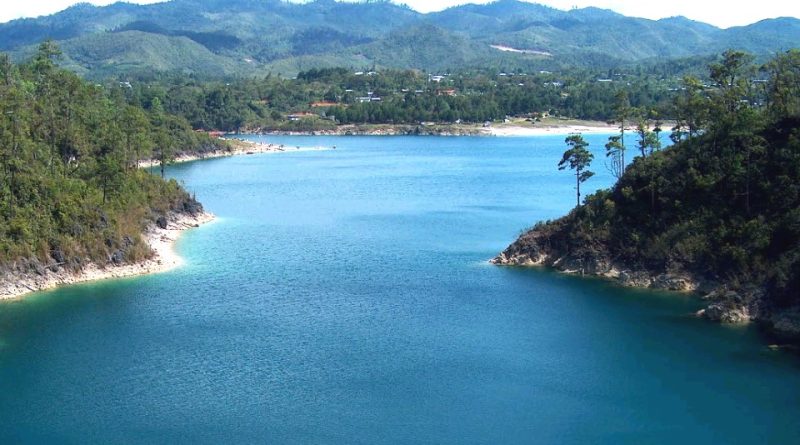Lagoons of Montebello National Park
Lagoons of Montebello National Park
Lagoons of Montebello National Park is a national park in the Mexican state of Chiapas, near the border with Guatemala, comprising 59 multicolored lakes in a pine forest and two Mayan ruins. It was Chiapas’ first national park when it was created in 1959; in 2009 the park was designated a UNESCO Biosphere Reserve.
Geography –
Lagoons of Montebello National Park is located in the municipalities of La Trinitaria and La Independencia in the southeastern state of Chiapas, near Guatemala. The closest town is Comitán, an hour’s drive west; the popular resort town of San Cristóbal de las Casas is another two hours to the west.
This park covers an area of 6,411 hectares, of which 3,412 hectares are considered the “core zone”. It is located in the highlands of Chiapas, with an altitude between 1,500 and 1,800 meters above sea level.
The main attractions of the national park are its 59 lakes, collectively called the lakes of Montebello. The lakes are famous for their striking colors, which vary due to their different mineral content, ranging from emerald and turquoise to dark green, purple and reddish black. About 15 of the lakes are easily accessible by car or on foot. Lake Tziscao is the largest of the lakes with a village nearby. Other lakes include Montebello, La Cañada, Pojoj, and a group of five lakes known as Lagunas de Colores (Lakes of Colors: Encantada, Ensueño, Esmeralda, Agua Tinta, and Bosque Azul). Many of the lakes are open for swimming, canoeing and kayaking. In the park there are also cenotes and a group of limestone caves called Grutas San Rafael dell’Arco, which can be visited on foot or on horseback. Scientists have recently expressed concern that the lakes are losing their colors and becoming muddy and lifeless. This is due to untreated sewage and agricultural runoff entering the lakes (via the Grande River which flows directly into the lakes) and deforestation of parts of the lake basins.
Metzabok Lake, which normally covers 89 hectares, dried up completely in August 2019 due to drought. Six other lagoons outside the park have also dried up.
Also within the park boundary are the medium-sized Mayan ruins of Chinkultic, a pre-Columbian city that dates back to the 3rd century and was abandoned in the 13th century. The site has not been fully excavated and many of the buildings are still hidden by vegetation. From the top of the Acropolis, the main pyramid, you can get a great view of many of the national park’s multicolored lakes. There are nearly 200 buildings including several pyramids and a single asymmetrical ballcourt, whose hieroglyphic inscriptions indicate it was dedicated in May 591. Carved steles depicting Chinkultic rulers are scattered among the ruins.
Climate –
The Lagoons of Montebello National Park, located in the municipality of La Trinitaria, Chiapas, Mexico; this is a place characterized by its natural, historical and archaeological tourist attractions, a unique natural beauty, by its lakes of different colors, caused by the nature that surrounds it, simply a magical place.
The climate is temperate with rain all year round. The average temperature is 18°C.
However, depending on the altimetric conditions and the geographical characteristics present, the climate can be divided mainly into three types: humid tropical, humid subtropical and mountain temperate.
Humid tropical climate: It is found in the coastal regions and northern lowlands of Chiapas. These areas are characterized by warm temperatures all year round, with daytime averages ranging from 25°C to 35°C, and night-time temperatures that can drop to between 20°C and 25°C. Precipitation is abundant, especially during the rainy season from May to October.
Humid subtropical climate: It is found in the central areas of Chiapas, mainly in the mountainous and hilly regions. Here the temperatures are generally milder than in the coastal areas, with daytime averages ranging from 20°C to 30°C. Nights can be cooler, with temperatures around 15°C. Precipitation is still significant, with a rainy season running from May to November.
Temperate mountain climate: It is found in the high mountains of Chiapas, such as in the elevated areas of the Sierra Madre de Chiapas. Here the climate is cool and more temperate than the surrounding regions. Temperatures can drop significantly, especially at night, and rainfall is relatively less abundant.
Flora –
According to the National Information System on Biodiversity of the National Commission for the Knowledge and Use of Biodiversity (CONABIO) in the national park Lagune di Montebello there are more than 2,315 species of plants and animals, of which 185 fall into a risk category of the official Mexican Standard NOM-059 and 24 are exotic. 5.6
The inspiration provided by the incomparable beauty of the Montebello area is not due only to the bodies of water, but also to a prodigious vegetation among which the tall specimens of pines, oaks, eucalyptus stand out; tree that produces styrax or American frankincense, all adorned with epiphytic plants, which create wonderful hanging gardens.
Wildlife –
In the Lagune di Montebello national park we find a rich fauna including some amphibians such as frogs, toads and salamander. Among the reptiles are the tortoise, some varieties of snake. The mammals that can be observed in the place consist of common species of the region. There’s the deer, the armadillo, the white-tailed fox, the anteater, the opossum. Some endangered species such as the puma and the jaguar inhabit this park. As for birds, both local and migratory, such as wild duck, chachalaca, dove and the bird with beautiful feathers, the quetzal.
In winter on the roads you can see how the fog clears and you can see with the naked eye a great immensity of Cobwebs in the Morning Dew and of course the spiders themselves (nephilas), and their great variety of sizes.
Guido Bissanti


